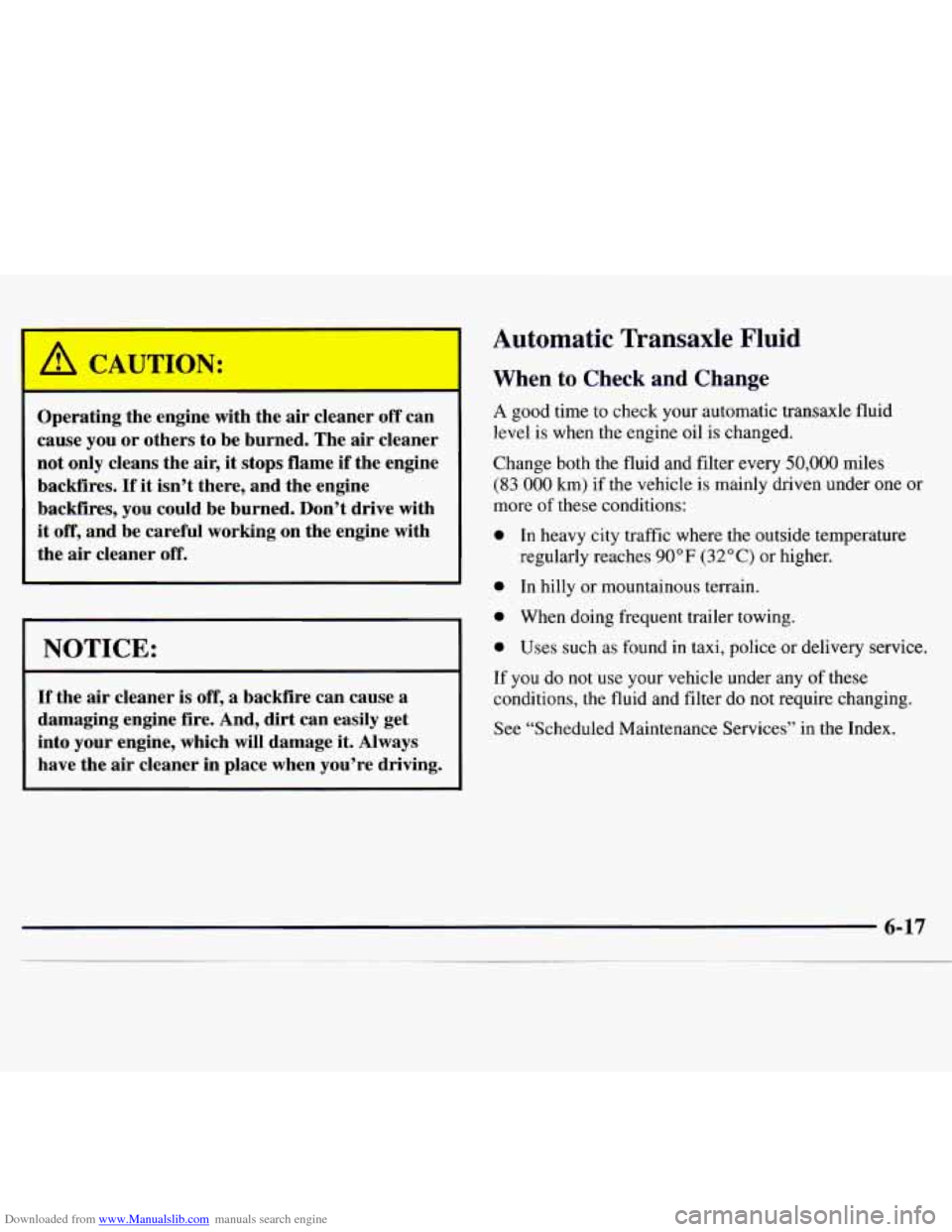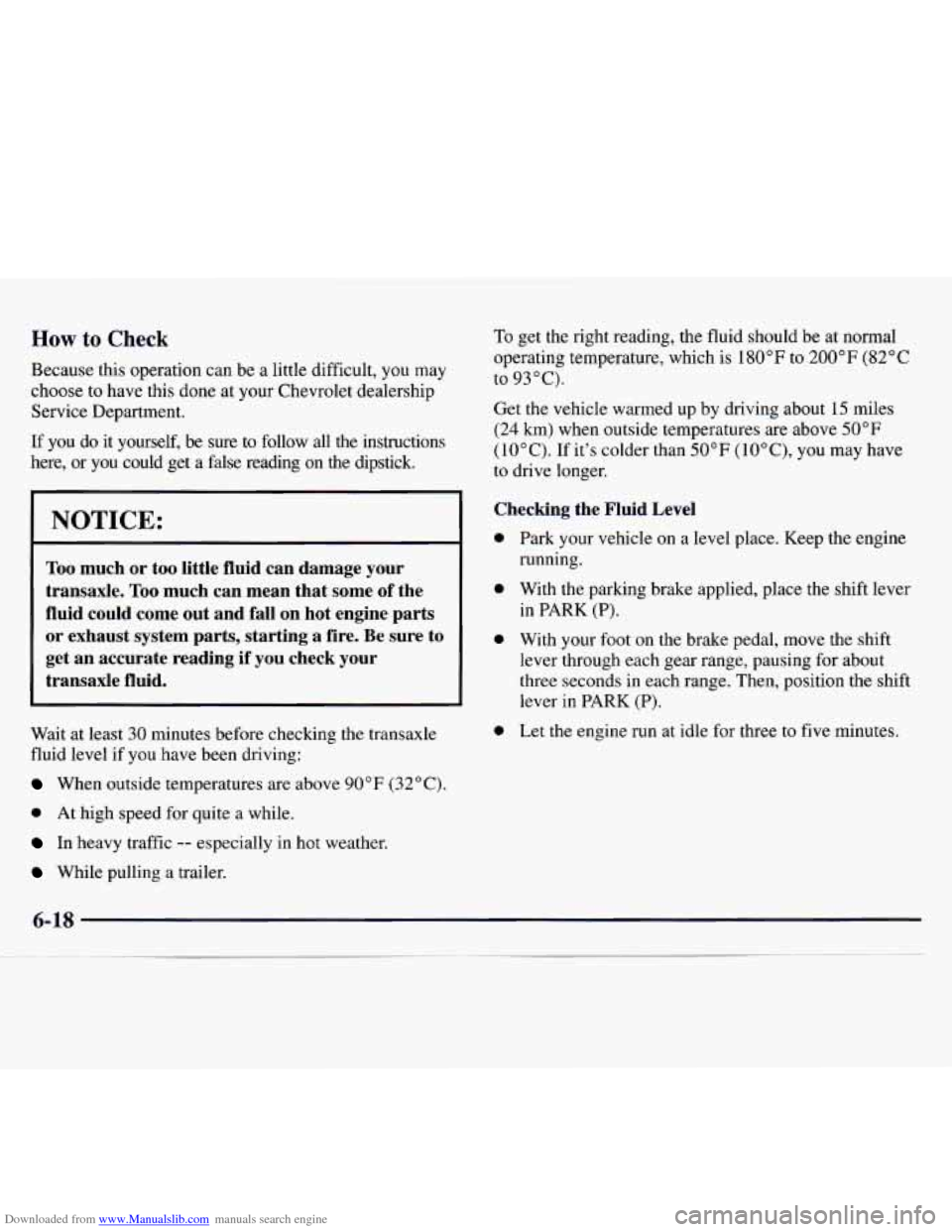Page 225 of 358
Downloaded from www.Manualslib.com manuals search engine Before closing the hood, be sure all the filler caps are on
properly. Then just pull the hood down and close it firmly.
Engine Oil
LOW
OIL
If the LOW OIL light on the
instrument panel comes on,
it means
you need to check
your engine oil level right
away. For more
information, see “Low Oil
Level Light” in the Index.
You should check your
engine oil level regularly;
this is an added reminder.
It’s a good idea to check your engine oil every time
you
get fuel. In order to get an accurate reading, the oil must
be warm and the vehicle must be on level ground.
3100 (Code M) Engine 3.4L DOHC (Code X)
Engine
The engine oil dipstick handle is the yellow loop near
the front of the engine.
Turn off the engine and give the oil a few minutes to
drain back into the oil pan. If you don’t, the oil dipstick
might
not show the actual level.
Page 226 of 358
Downloaded from www.Manualslib.com manuals search engine Checking Engine Oil
If you have the 3.4L DOHC engine (VIN Code X),
allow up to 20 minutes for the oil to drain back into the
oil pan.
Pull out the dipstick and clean it with a paper towel or
cloth, then push it back in all the way. Remove it again,
keeping the tip down, and check the level.
3100 (Code M) Engine 3.4L DOHC (Code X)
Engine
When to Add Oil
If the oil is at or below the lower mark, then you’ll need
to add at least one quart of oil. But you must use the
right kind. This part explains what kind
of oil to use. For
crankcase capacity, see “Capacities and Specifications”
in the Index.
I NOTICE:
Don’t add too much oil. If your engine has so
much oil that the oil level gets above the
cross-hatched area that shows the proper
operating range, your engine could be damaged.
6-11
Page 231 of 358
Downloaded from www.Manualslib.com manuals search engine Air Cleaner
F
To check or replace the air filter, remove the four screws
and pull
off the cover. Pull out the filter.
Be sure to install the air filter and
install the cover tightly when you are finished.
Refer to the Maintenance Schedule to determine when to
replace the air filter.
See “Scheduled Maintenance Services”
in the Index.
Page 232 of 358

Downloaded from www.Manualslib.com manuals search engine r--
Operating the engine with the air cleaner off can
cause you or others to be burned. The
air cleaner
not only cleans the air, it stops flame if the engine
backfires.
If it isn’t there, and the engine
backfires, you could be burned. Don’t drive with
it off, and be careful working on the engine with
the air cleaner
off.
I NOTICE:
If the air cleaner is off, a backfire can cause a
damaging engine fire. And, dirt can easily get
into your engine, which will damage
it. Always
have the
air cleaner in place when you’re driving.
Automatic Transaxle Fluid
When to Check and Change
A good time to check your automatic transaxle fluid
level
is when the engine oil is changed.
Change both the fluid and filter every
50,000 miles
(83 000 km) if the vehicle is mainly driven under one or
more of these conditions:
0 In heavy city traffic where the outside temperature
regularly reaches
90°F (32°C) or higher.
0 In hilly or mountainous terrain.
0 When doing frequent trailer towing.
0 Uses such as found in taxi, police or delivery service.
If you do not use your vehicle under any of these
conditions, the fluid and filter do
not require changing.
See “Scheduled Maintenance Services” in the Index.
Page 233 of 358

Downloaded from www.Manualslib.com manuals search engine How to Check
Because this operation can be a little difficult, you may
choose to have this done at your Chevrolet dealership
Service Department.
If you do it yourself, be sure to follow all the instructions
here,
or you could get a false reading on the dipstick.
NOTICE:
Too much or too little fluid can damage your
transaxle.
Too much can mean that some of the
fluid could come out and fall on hot engine parts
or exhaust system parts, starting a fire. Be sure to
get an accurate reading if you check your
transaxle fluid.
Wait at least 30 minutes before checking the transaxle
fluid level if you have been driving:
When outside temperatures are above 90 "F (32°C).
0 At high speed for quite a while.
In heavy traffic -- especially in hot weather.
While pulling a trailer.
To get the right reading, the fluid should be at normal
operating temperature, which is
180°F to 200°F (82°C
to
93°C).
Get the vehicle warmed up by driving about 15 miles
(24 km) when outside temperatures are above 50°F
(10°C). If it's colder than 50°F ( 10°C), you may have
to drive longer.
Checking the Fluid Level
0
0
0
0
Park your vehicle on a level place. Keep the engine
running.
With the parking brake applied, place the shift lever
in PARK
(P).
With your foot on the brake pedal, move the shift
lever through each gear range, pausing for about
three seconds in each range. Then, position the shift
lever in PARK (P).
Let the engine run at idle for three
to five minutes.
Page 234 of 358
Downloaded from www.Manualslib.com manuals search engine Then, without shutting off the engine, follow
these steps:
3100 (Code M) Engine 3.4L DOHC (Code X)
Engine
3100 (Code M) Engine 3.4L DOHC (Code X)
Engine
1. The transaxle fluid dipstick handle is the red loop
near the back
of the engine. Pull out the dipstick and
wipe it with a clean rag or paper towel.
then pull
it back out again.
2. Push it back in all the way, wait three seconds and
3. Check both sides of the dipstick, and read the
lower level. The fluid level must be
in the
cross-hatched area.
4. If the fluid level is in the acceptable range, push the
dipstick back in all the way.
6-19
Page 235 of 358
Downloaded from www.Manualslib.com manuals search engine How to Add Fluid
Refer to the Maintenance Schedule to determine what
kind
of transaxle fluid to use. See “Recommended
Fluids and Lubricants” in the Index.
If the fluid level is low, add only enough of the proper
fluid to bring the level into the cross-hatched area on
the dipstick.
1. Pull out the dipstick.
2. Using a long-neck funnel, add enough fluid at the
dipstick hole to bring it to the proper level.
It doesn’t take much fluid, generally less than one
pint
(0.5 L). Don’t ovefill.
We recommend you use only fluid labeled
DEXRON@-III, because fluid with that label
is
made especially for your automatic transaxle.
Damage
caused by fluid other than DEXRON-III
is not covered by your new vehicle warrantv.
3. After adding fluid, recheck the fluid level as
described under “How to Check.’’
4. When the correct fluid level is obtained, push the
dipstick back in all the way.
Page 237 of 358
Downloaded from www.Manualslib.com manuals search engine NOTICE:
If you use an improper coolant mix, your engine
could overheat and be badly damaged. The
repair cost wouldn’t be covered by your
warranty.
Too much water in the mix can freeze
and crack the engine, radiator, heater core and
other parts.
If you have to add coolant more than four times a year,
have your dealer check your cooling system.
I NOTICE: I
If you use the proper coolant, you don’t have to
add extra inhibitors or additives which claim to
improve the system. These can
be harmful.
Checking Coolant
When your engine is cold, the coolant level should be at
the
COLD mark or a little higher. When your engine is
warm, the level should be
up to the HOT mark or a
little higher.
6-22